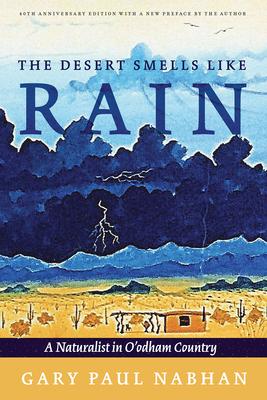Published more than forty years ago, The Desert Smells Like Rain remains a classic work about nature, how to respect it, and what transplants can learn from the longtime residents of the Sonoran Desert, the Tohono O’odham people.
In this work, Gary Paul Nabhan brings O’odham voices to the page at every turn. He writes elegantly of how they husband scant water supplies, grow crops, and utilize edible wild foods. Woven through his account are coyote tales, O’odham children’s impressions of the desert, and observations of the political problems that come with living on both sides of an international border. Nabhan conveys the everyday life and extraordinary perseverance of these desert people. This edition includes a new preface written by the author, in which he reflects on his gratitude for the O’odham people who shared their knowledge with him. He writes about his own heritage and connections to the desert, climate change, and the border. He shares his awe and gratitude for O’odham writers and storytellers who have been generous enough to share stories with those of us from other cultural traditions so that we may also respect and appreciate the smell of the desert after a rain. Longtime residents of the Sonoran Desert, the Tohono O’odham people have spent centuries living off the land--a land that most modern citizens of southern Arizona consider totally inhospitable. Ethnobotanist Gary Nabhan has lived with the Tohono O’odham, long known as the Papagos, observing the delicate balance between these people and their environment. Bringing O’odham voices to the page at every turn, he writes elegantly of how they husband scant water supplies, grow crops, and utilize wild edible foods. Woven through his account are coyote tales, O’odham children’s impressions of the desert, and observations on the political problems that come with living on both sides of an international border. Whether visiting a sacred cave in the Baboquivari Mountains or attending a saguaro wine-drinking ceremony, Nabhan conveys the everyday life and extraordinary perseverance of these desert people in a book that has become a contemporary classic of environmental literature.| FindBook |
有 1 項符合
The Desert Smells Like Rain: A Naturalist in O’Odham Country的圖書 |
 |
The Desert Smells Like Rain: A Naturalist in O’Odham Country 作者:Nabhan 出版社:University of Arizona Press 出版日期:2022-08-30 語言:英文 規格:平裝 / 176頁 / 普通級/ 初版 |
| 圖書館借閱 |
| 國家圖書館 | 全國圖書書目資訊網 | 國立公共資訊圖書館 | 電子書服務平台 | MetaCat 跨館整合查詢 |
| 臺北市立圖書館 | 新北市立圖書館 | 基隆市公共圖書館 | 桃園市立圖書館 | 新竹縣公共圖書館 |
| 苗栗縣立圖書館 | 臺中市立圖書館 | 彰化縣公共圖書館 | 南投縣文化局 | 雲林縣公共圖書館 |
| 嘉義縣圖書館 | 臺南市立圖書館 | 高雄市立圖書館 | 屏東縣公共圖書館 | 宜蘭縣公共圖書館 |
| 花蓮縣文化局 | 臺東縣文化處 |
|
|
圖書介紹 - 資料來源:博客來 評分:
圖書名稱:The Desert Smells Like Rain: A Naturalist in O’Odham Country
內容簡介
作者簡介
Gary Paul Nabhan is the Kellogg Endowed Chair at the University of Arizona’s Southwest Center. He is author or editor of more than thirty books, including Enduring Seeds, Gathering the Desert, and Food from the Radical Center. Honored with a MacArthur "Genius" Award, a Lannan Literary Fellowship, the John Burroughs Medal for nature writing, and other awards, Nabhan has lived in the desert for more than forty years.
Living and Dying in São Paulo: Immigrants, Health, and the Built Environment in Brazil
Living and Dying in São Paulo: Immigrants, Health, and the Built Environment in Brazil
Die Philippinen: Geschichte eines verloren gegangenen Paradieses
The Product of Medicine: How Efficiency Made American Health Care
Brothers Behind Bars: A History of the Muslim Brotherhood from the Palestine War to Egypt’s Prisons
Reel Freedom: Black Film Culture in Early Twentieth-Century New York City
Reel Freedom: Black Film Culture in Early Twentieth-Century New York City
Political Geography: World-Economy, Nation-State and Locality
Between Families and Institutions: Mental Health and Biopolitical Paternalism in Contemporary China
Working-Class Raj: Colonialism and the Making of Class in British India
Living and Dying in São Paulo: Immigrants, Health, and the Built Environment in Brazil
Die Philippinen: Geschichte eines verloren gegangenen Paradieses
The Product of Medicine: How Efficiency Made American Health Care
Brothers Behind Bars: A History of the Muslim Brotherhood from the Palestine War to Egypt’s Prisons
Reel Freedom: Black Film Culture in Early Twentieth-Century New York City
Reel Freedom: Black Film Culture in Early Twentieth-Century New York City
Political Geography: World-Economy, Nation-State and Locality
Between Families and Institutions: Mental Health and Biopolitical Paternalism in Contemporary China
Working-Class Raj: Colonialism and the Making of Class in British India
|











